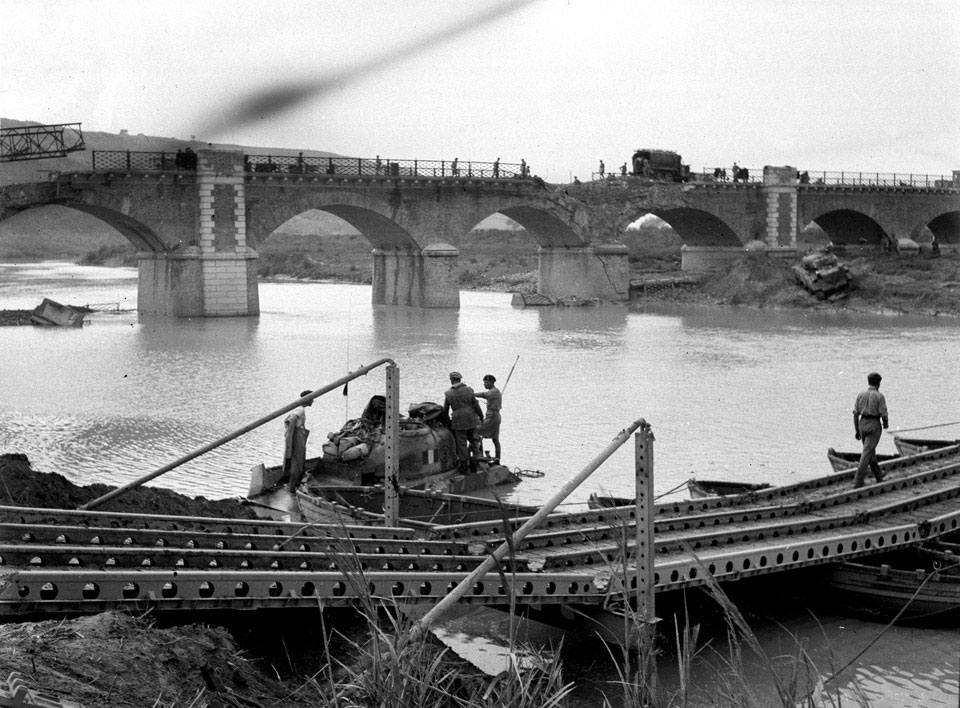
Online Collection
« Prev - 1 of 61 results - Next »
Building a Bailey Bridge on the River Biferno, October 1943
Photograph by Major Wilfred Herbert James Sale, MC, 3rd/4th County of London Yeomanry (Sharpshooters), World War Two, Italy, 1943.
Following the Allied invasion of Italy the Germans had set up a series of defensive lines across the country. The Volturno Line was the southernmost of these and included the RIver Biferno. The Biferno flows west to east into the Adriatic Sea just south of the town of Termoli. Control of the small but strategically valuable port of Termoli became the objective for both sides in October 1943.
Operation DEVON involved a force of commandos and other special forces landing from the sea. It successfully secured the port on the night of 2/3 October 1943, allowing Allied infantry units to ford the Biferno River and secure a bridgehead while engineers attempted to repair or replace bridges that the Germans had destroyed or damaged as they retreated.
The Allied position around Termoli quickly became isolated as flooding made the Biferno crossing hazardous, leaving the defenders desperately short of armour as the German 16th Panzer Division counterattacked.
On the night of the 4 October as Royal Engineers attempted to repair the main road bridge across the Biferno, a number of 'C' Squadron, 3rd County of London Yeomanry (Sharpshooters) tanks, commanded by Major Bobby Gale, successfully forded the river but the weight of the Sherman tanks soon made the ford unusable and at least one tank foundered in mid-stream.
As the isolated Allied forces in Termoli desperately tried to hold on to the town and the high ground which overlooked the river crossing, 'C' Squadron's tanks went into action defending the main road into the town. The Allies held out and the key bridge over the Biferno was repaired with sections of Bailey Bridge. This allowed Allied reinforcements, including the rest of the Sharpshooters to enter the battle on the afternoon of 5 October. The following day saw more Allied reinforcements arriving and the Germans were forced to retreat.
The photograph shows how a gap in this bridge across the Biferno has been bridged by a prefabricated section of Bailey Bridge (far left). Royal Engineers can be seen working on repairs to other damaged sections. On the far river bank is a ditched Mark 3 (M4A2) Sherman tank of 'C' Squadron, 3rd County of London Yeomanry (Sharpshooters). in the foreground is a new pontoon bridge with Lieutenant Kenneth Piggott and his crew standing on another semi-submerged Sherman named 'Cyclops'.
The 3rd County of London Yeomanry's war diary entry for 5 October 1943 records that 'C Sqn who were first to cross the Biferno river, went to their [11 Brigade's] support with all possible speed. Unfortunately after 6 tanks had crossed, the ford became unpassable and owing to the size of the blow in the bridge and to continuous enemy shelling, the REs [Royal Engineers] could not complete their work until 1420'.
From a photograph album containing 242 photographs compiled by Major W H J Sale, MC, 3rd/4th County of London Yeomanry (Sharpshooters).
NAM Accession Number
NAM. 1975-03-63-15-5
Copyright/Ownership
National Army Museum Copyright
Location
National Army Museum, Study collection
Object URL
https://collection.nam.ac.uk/detail.php?acc=1975-03-63-15-5

